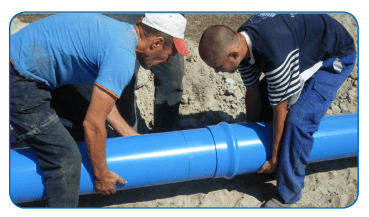PVC-O and PE joint procedures
The article below outlines the differences between making a push-fit connection on PVC-O pipes and Butt Fusion Welds required for PE pipes.
PVC-O Pipe Joint Procedure
The connection is made by introducing the male (spigot) part of the pipe into the socket where the elastic joint is placed. The leak tight seal includes a PP ring and a synthetic rubber lip which allows the seal to be an integrated part of the pipe, avoiding joint displacement or movement while installation is taking place. Steps to achieve a perfect joint are detailed below:

- Remove the protective caps and verify that the pipe is clean and in good condition.
- It must be confirmed that the socket and bevel ends are clean and free from grit.
- Check that the bevel end is correct and free of cracks.
- Lubricate the bevel and socket with a thin layer of joint lubricant.
- Align the pipe as much as possible in both a horizontal and vertical direction to ensure correct alignment.
- Slot the bevel end pipe of one pipe to just inside opening of the socket of the second pipe.
- For smaller diameter pipes owing to the elastic joint system and the lightness of the pipe a short sharp lateral movement of the hand is enough to couple the pipes. Pipes should be pushed home until the insertion mark on the spigot end of the pipe is no longer seen. Larger diameter pipes can be slotted into one another using levers or mechanical equipment to create the lateral movement to create the joint.
PE Pipe Butt Fusion Joint Procedure and Requirements

Equipment Required:
- Generator to supply the heater plate, trimmer and hydraulic pump.
- Butt-Fusion machine fitted with the correct size clamp shells, trimmer, heater plate, hydraulic pump and timer.
- Pipe support rollers.
- Welding tent.
- Cleaning material, lint-free cotton cloth or paper towel.
- External/internal de-beading tool.
- Bead gauge.
- Digital thermometer with surface probe to check heater plate.
- Pipe end caps.
- Baseboard.
- Pipe cutters.
- Air temperature thermometer.

- Indelible marker pen.
- Timer.
Procedures
Training Courses
It is essential that all installers of polyethylene pipe systems have received thorough training.

Welding in Cold Weather
When butt fusion jointing at temperatures below 0⁰ C, a space heater should be provided for the welding shelter to raise the local temperature above 0⁰ C.
Welding Requirements
- Ensure that equipment used is clean, in good condition and regularly maintained.
- Do use a shelter and ground sheet (a suitable antislip surface*), both in dry and wet conditions, to minimise contamination, and fit end protection to pipes, (plugs or caps) to eliminate draughts.
- Ensure that the correct jointing parameters for the machine type and pipe are known.
- Check that the heater plate is clean and dry.
- Check that the trimmer is clean and that the blades are not damaged and in the correct position for required pipe size.
- Ensure clamp liners and securing screws are of the correct size.

- Ensure that the generator is in good condition and has sufficient fuel.
- The pipes and/or fittings to be jointed are of the same size, SDR and material.
Dummy Welds (Has to be done every day and takes up time and material)
Even though washing of the heater plate may remove large deposits of dirt, very fine particles of dust may still remain on the heater plate. To remove such dust it is necessary to make a dummy joint at the start of each jointing session, whenever the plate has been allowed to cool below 180°C, or at a change of pipe size. Two dummy joints must be made if the pipe size is greater than 180mm.
Post Weld Checks
- Examine the joint for cleanliness and uniformity and check that the bead width is within the specified limits.
- Remove the external bead and if required the internal bead using suitable de-beading tools.
- The beads and joint should be numbered/coded using an indelible marker pen to correspond with the joint details entered into the butt fusion machine data retrieval system.
- The beads should be twisted at several positions and if a bead is seen to split at any point or deformities are present on the underside, then the joint should be cut out from the pipeline and remade.
- If a similar defect reoccurs, all further jointing should cease until the equipment has been thoroughly cleaned, examined and new trial joints made which are shown to be satisfactory.
- The prescribed pressure must be maintained for the required minimum cooling time.
- After this time the assembly can be removed from the machine but should not be handled excessively for the required period.
Health & Safety
- Never allow hot polyethylene to come into contact with the skin. In such an event cold water should be used to cool the affected area. Expert medical advice must be sought.
- Under no circumstances should any attempt be made to remove any material that becomes stuck on the skin without medical supervision, as this would risk more serious injury.
- Care should be exercised by taking normal precautions when using electrical equipment on site, particularly in wet conditions.
- Normal precautions should be observed when handling electrical equipment. For safety reasons, all 110v portable generator sets should be ‘Centre Tapped’ for site use +55/0/-55 volts.
- Consideration should be given to a firm level base such as 19mm Marine Ply.
Joint procedures
PVC-O
- No special equipments needed.
- Training courses are not needed.
- No need of special health and safety measures.
PE
- Special equipments required.
- Training courses for installers.
- Special technical requirements for welding.
- Post-weld checks needed.
- Special health and safety measures must be takent into account.
